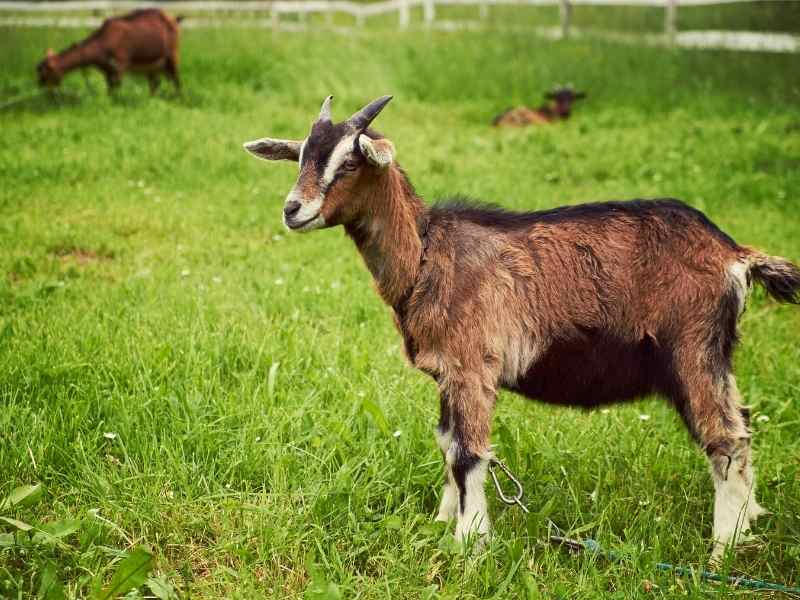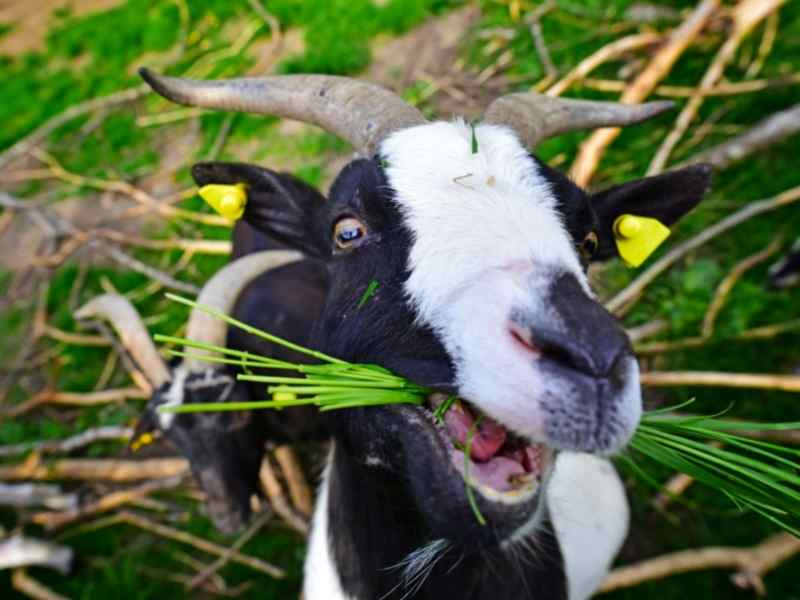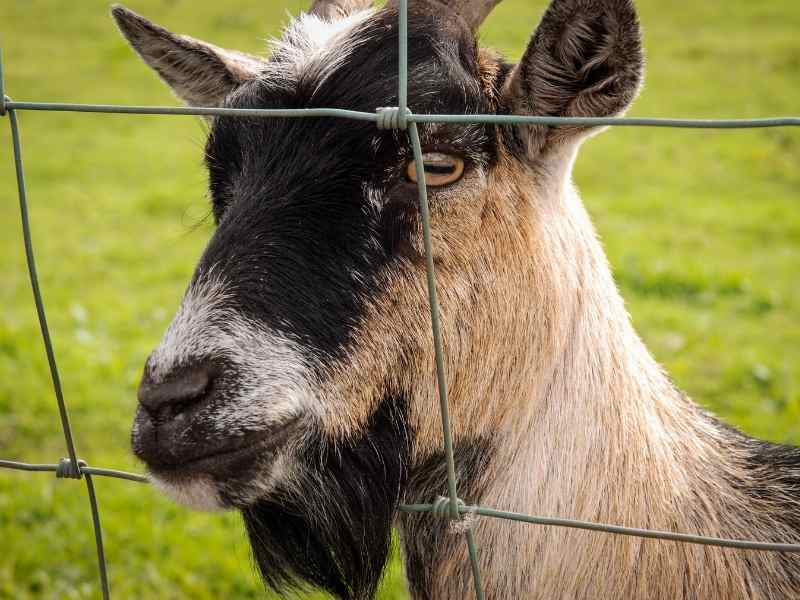Goats can be a blessing in small numbers but a curse when overstocked, so you need to know a few things before getting some. They are highly intelligent and entertaining animals with several permaculture uses, but if you have too many, they will raze your garden to the ground.

Goats are good for a permaculture homestead when properly managed and cared for. Their manure can be applied directly to crops as fertilizer or used to make compost. They can be used to clear wasteland of weeds, thorns, and brambles for permaculture, and their smaller hooves don’t damage the soil.
Goats can provide milk and meat in addition to fitting into your permaculture cycles for soil improvement, weed management, natural productivity, and sustainability. They require less pasture than larger livestock and are pretty hardy animals.
Benefits Of Keeping Goats
Goats Are Smaller Than Other Hooved Animals
Goats don’t need as much space as other animals such as cattle and sheep as they are smaller and are browsers, not grazers. You can keep two goats or twenty depending on the size of your homestead and how you intend to use them.
They don’t need as much feed as cattle and eat a broader range of plants than sheep. However, goats can still produce manure for use on crops, and it is not as strong as chicken cow or horse manure. There is thus less risk of nitrogen burns to crops.
Their smaller hooves also cause less damage to the soil than those of larger livestock, reducing soil erosion and compaction.
Weed control
Goats can be used to manage areas overgrown with weeds. They can eat many different types of weeds, even prickly ones like thistles, and eliminate the need for herbicides. They can also be used to keep a lawn relatively short.
Take a leaf from the book of a small farmer in El Salvador who was battling to clear an overgrown acre of land completely covered in weeds, thorns, and brambles. He tried using a machete for a couple of days and got covered in scratches and cuts from the thorns while hardly making a dent in the dense overgrowth. Then he noticed that a neighbor’s goats liked to forage on those same weeds and brambles.
He bought two goats, tied them to stakes within reach of the overgrown area, and watched as they ate their way through the problem plants. He moved them further inwards each day. After a month, the land was cleared and fertilized with goat manure to boot. With the subsequent planting of a diversified fruit orchard interspersed with nitrogen-fixing trees, he turned the wasteland into a healthy agroforestry system.
Goats should not be allowed near fruit trees or other crops because they will consume them. You need to rotate the goats between pastures to ensure they are not over-grazed, which requires robust fencing, goat pens, and monitoring.

Raising Goats Is Simple
Goats are infamous for eating just about anything, including your washing on the line, so you need to have a few rules for keeping them. Goats can eat grass, but they are mainly browsers and therefore prefer foraging for leaves, branches, and other edibles above ground level. Sheep and cattle, by contrast, are grazers and eat grass at ground level.
Goats forced to graze on grass are vulnerable to bacterial infections and parasites from the soil. For this reason, when feeding them, you should always use a raised trough instead of scattering their food on the ground. A central tenet of permaculture is to use animals’ natural behaviors to benefit the land, so you should take advantage of goats’ inclination to browse.
Goats are hardy and low maintenance if you know what you’re doing. You can feed them hay and scraps from the kitchen or garden. In a suburban setting, you can collect the vegetable waste from greengrocers and similar stores for the goats. You can also let them eat plant waste from your own garden or household, including outer cabbage leaves, banana peels, broccoli stems, and carrot tops.
- Belanger, Jerry (Author)
- English (Publication Language)
- 296 Pages - 02/06/2018 (Publication Date) - Storey Publishing, LLC (Publisher)
Last update on 2024-07-26 / Affiliate links / Images from Amazon Product Advertising API
Goats cannot thrive on grass alone, so you must ensure their diet is varied. You will probably have to supplement their food with hay or feed pellets when keeping them for milk or meat. Goats do better in dryer climates, and many breeds can handle hot and cold conditions. However, they don’t do so well in wet environments.
They are usually seasonal breeders and have two or more kids a year. The females are called does or nanny goats, while the males are called bucks or billy goats. A wether is a castrated male, and a kid is less than twelve months of age.
Goats are however notorious for testing a fence and finding a way to the other side. When I was 13 years old I had a few goats escape the fence in our pasture and try to get on the morning school bus with me.
Fencing for goats must be robust and sturdy because they are agile and can climb. You need to keep the bucks separate from the does. If mountain lions, coyotes, stray dogs, or other predators occur in your area, you need fencing to keep the goats safe. You can also use dogs, donkeys, and llamas to guard the goats.

Goats can die from overeating. If they have an abrupt change in their diet or are fed heavily concentrated feeds, this can be too much for their system to handle. Ensure they cannot get into the feed storage bins!
You should get at least two goats because they are social animals and get lonely without companionship. Two females are better than a buck and a doe because bucks can be a hassle. You could also keep a wether and a doe together. If you want to breed your two females, you can borrow a buck from a local breeder or use artificial insemination.
Goats Can Form A Cycle With Nitrogen-Fixing Trees
Goats can be valuable on small-scale farms and homesteads because they produce food for human consumption and manure for crop fertilization. You can grow nitrogen-fixing trees like the false acacia, foxglove tree, or velvet mesquite for them to browse on.
In combination with the rhizobium bacteria, these trees help pull nitrogen from the air into the soil. Nitrogen-fixing trees enrich the soil and aid in pest control and water treatment through filtration.
They provide fodder for goats, grow fast, and propagate easily. They stabilize soil, decrease erosion, can be used as living fences, and provide fence poles and fuelwood. They also have deep roots that don’t compete with crops for nutrients.
The goats browse on these trees, producing manure that can be returned to the soil and fertilize crops. When selecting nitrogen-fixing trees, you should always choose indigenous species as they are more likely to flourish. You can also lop off tree branches and feed them to the goats to restrict their access to the tree itself.
Goats Provide Fertilizer
You can herd them into a raised pen at night to harvest goat manure. The enclosure should have a floor made of slats that are slightly apart, with a tank below to collect their urine and feces. You then add worms to the pile to speed up decomposition and increase nutrients through worm castings. Mayan farmers have used this technique with great success to fertilize their lands after the corn harvest.
Goat droppings are small pellets that typically don’t attract insects and don’t have a strong smell like cattle or chicken manure. Their droppings won’t burn plants and can be applied directly to the soil in vegetable gardens.
The pellets are easily spread and tilled into the earth. You can use the manure to enrich the soil in the fall after the harvest and let it soak in during the winter months.
You can also compost goat manure by mixing it with dead leaves, grass clippings, eggshells, straw, and kitchen scraps. Turn the mix to increase airflow and decomposition rate. The goat manure pellets facilitate airflow through the compost pile, speeding up the process.
Goats Can Be Used For Meat
Certain goat breeds can be kept for meat to increase your self-sufficiency or sell commercially. Goat meat is also known as chevon in the US. It is lean, full of protein, and particularly popular with certain religious and ethnic groups.

Boer goats are perfect for meat production. They put on weight faster than other breeds but don’t produce much milk. Some farmers prefer hybrids of Boer goats and Nubian goats, so they benefit from the meat and the milk. Goats bred for meat need a dry, warm, clean shelter out of the wind.
Boer goats are white, red, or reddish-brown and shorthaired and have red, black, or brown markings on their heads and necks. The horns are short and curve close to the head.
Any breed of goat can be used for meat, but those bred specifically for meat mature more quickly and put on more weight so they can be brought to market sooner. Boer goats are resistant to disease and do well in hot, dry, and semi-arid regions. They can be slaughtered at ninety days of age.
Boer goats are often crossed with Alpine, Toggenburg, and Saanen goats which are dairy breeds. You don’t have to buy pedigreed or champion goats for meat production. Mixed breeds work just fine. Goat meat has forty percent less saturated fat than skinless chicken.
Goats are much more productive and efficient than beef cattle. They have a shorter gestation period, and twins and triplets are common.
- Zweede-Tucker, Yvonne (Author)
- English (Publication Language)
- 224 Pages - 01/15/2012 (Publication Date) - Voyageur Press (Publisher)
Last update on 2024-07-26 / Affiliate links / Images from Amazon Product Advertising API
Spanish goats used to be the standard meat goat until the Boer breed came along. They are descendants of the goats brought to the Americas by the Spanish. They are still valued for controlling invasive brush like buckthorn.
Savanna goats are heat and drought-resistant. They have short, white coats and a warm undercoat that make them adaptable to different weather conditions.
Kiko goats are large, white hardy goats that thrive in poor conditions. They are only raised for meat and were first developed in New Zealand. Kikos are fast-growing, and males can get up to three hundred pounds. However, they require a lot of land, so they are probably not suitable for most homesteads.
Goats Can Be Kept For Milk and Cheese
There are breeds of dairy goats that are kept mainly for milk production. Their milk can be used to make goat’s cheese or sold commercially. Soap and lotions can also be made from goats’ milk.
- Hurst, Janet (Author)
- English (Publication Language)
- 192 Pages - 01/14/2013 (Publication Date) - Voyageur Press (Publisher)
Last update on 2024-07-26 / Affiliate links / Images from Amazon Product Advertising API
The best goat breeds for milk are Alpine, Saanen, Oberhasli, and Toggenburg goats that have their origins in Switzerland. They flourish in cooler climates. The Nubian goat and the Nigerian Dwarf goat are also good milk producers. The Nigerian Dwarf goat produces milk high in butterfat, making it good for goat cheese.
Saanen goats are white or cream-colored and may have spots on the skin. They are popular with commercial dairies for their calm demeanor and high milk production. Sable goats produce the same quantities of milk as Saanens and also have a stable temperament.
Dairy goats need milking twice a day. They can produce enough milk for you to milk them and still feed their kids, although the kids can also be hand-reared to keep the milk for other purposes. A doe can average three quarts of milk a day for around ten months.
Good quality feed is essential for lactating nannies. Milkings should be twelve hours apart, and bedding must be kept clean to avoid mastitis, an infection in their teats. When you want a doe to stop producing milk, you have to gradually reduce the portion of her concentrated feed over seven to ten days and feed lower quality hay or pasture.

The lifespan of a dairy goat is between eight and twelve years. They need an all-year supply of roughage, and winter browsing and pastures must be supplemented with hay. Alfalfa is good for milking, breeding, and growing dairy goats.
The mother usually feeds the kids on milk for up to two to three months, but they should start trying to browse at two weeks and eating grain at four weeks. Dairy goats need access to fresh, clean water, salt, and minerals. They will not eat contaminated food.
Dairy goats do not thrive when tethered. They prefer to browse brushlands, pasture plants, and non-toxic weeds. Pens with dirt floors are preferable to cement, and they need a dry, clean shelter out of the wind.
Each goat requires fifteen square feet of bedding. Dairy goats are herd animals and should not be kept alone. You should get at least two goats to keep each other company. Bucks must be separated from lactating does.
Conclusions
You need to do some forward planning before buying goats to make the best use of them on your permaculture homestead. If you understand what you are getting into, raising goats has many advantages compared with other livestock. They can provide environmentally friendly weed control, fertilizer for your crops, entertainment, milk, and meat.





